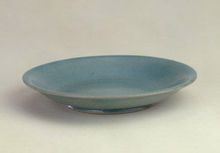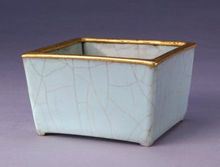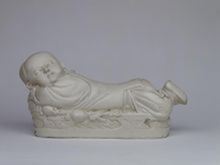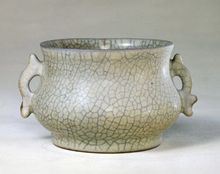The saying of the five famous kilns of the Song Dynasty first appeared in the Ming dynasty's imperial collection catalogue, “The Annals of Xuande Ritual Bronzes”: “The inner treasury houses Chai, Ru, Guan, Ge, Jun, and Ding kiln porcelain pieces with elegant designs, whose images were presented to the emperor.” In his book “Sayings on Porcelain at the Drinking Stream Studio,” Xu Zhiheng of the Qing dynasty said, “Chinese porcelain production can be divided into three major periods: Song, Ming, and Qing. The most famous of the Song period are five, namely Chai, Ru, Guan, Ge, and Ding. There is also Jun kiln, which is also very valuable.” Since no site or actual pieces of Chai kiln have been found to date, Jun kiln is usually included, alongside Ru, Guan, Ge, and Ding, as one of the five famous kilns of the Song Dynasty.
Ru Kiln
【Introduction】

Song Dynasty Ru Kiln Sky-blue Glazed Plate
Ru ware is considered the foremost of the five famous kilns, with its kiln site located in Qingliansi Village, Daying Town, Baofeng County, Henan Province, which was part of Ruzhou during the Song Dynasty. Archaeological excavations have revealed a Ru kiln area of about 250,000 square meters, which was already considered large for its time. In fact, the production of Ru ware began from the early Song Dynasty, reaching its peak in the late Northern Song Dynasty.
【Artistic Characteristics】
Ru kiln primarily produced celadon wares, with characteristics such as “sky-blue glaze color,” “crab-claw pattern,” “incense-gray body,” and “sesame seed spurs” being important criteria for identification. Among these, “crab-claw pattern” refers to the texture of the crackle glaze, while “sesame seed spurs” result from using small supports to elevate the ware during firing, leaving a few points on the bottom of the piece after firing. Generally, the body of Ru kiln porcelain is relatively thin, with a thick glaze that has a jade-like quality and fine crackle. The shapes tend to be dignified and grand.
Due to the scarcity of surviving Ru kiln works—estimated to be fewer than a hundred—they are extremely precious because of their exquisite craftsmanship.
【Representative Works】
The Palace Museum in Beijing houses pieces such as Ru Kiln Sky-blue Glazed Stringed Vase, Ru Kiln Sky-blue Glazed Circular Basin, and Ru Kiln Sky-blue Glazed Bowl. Meanwhile, the National Palace Museum in Taipei houses works like the Ru Kiln Sky-blue Unpatterned Elliptical Water Lily Basin and Ru Kiln Pale Celadon Lotus-shaped Warming Bowl.
Guan Kiln
【Introduction】

Song Dynasty Guan Kiln Celadon Square Flower Pot
The Song Dynasty Guan kiln was directly established by the government, divided into Northern Song Guan kiln and Southern Song Guan kiln. The Northern Song Guan kiln began producing in the late Northern Song Dynasty during Emperor Huizong's reign, but its specific location remains unknown. After Emperor Gaozong crossed the river to the south, a new kiln was set up in Lin'an (today's Hangzhou), one “within the Bureau of Palace Construction” and another “at the Suburban Altar.” Analysis suggests that the “Guan Kiln within the Bureau of Palace Construction” was located at the foot of Phoenix Mountain in Hangzhou, while the “Suburban Altar Guan Kiln” was situated near Turtle Hill in Hangzhou. To differentiate them, the Northern Song Guan kiln is referred to as “Old Guan,” while the Southern Song Guan kiln is called “New Guan.” “Old Guan” is characterized by its thickness, whereas “New Guan” is lighter and thinner.
【Artistic Characteristics】
Song Dynasty Guan kiln porcelain is mainly plain, without elaborate decorations or colorful paintings. At most, it uses straight ridges and string patterns for embellishment. Its body is iron-black, and its glaze is pale celadon, with the “purple rim and iron foot” adding an ancient elegance. “Purple rim and iron foot” refers to the gray or gray-purple exposed edges of the ware and the black-brown or dark gray unglazed bottoms due to the high iron content (3.5%–5%) in the celadon clay. Apart from common forms like dishes, bowls, and basins, there are also many imitations of various vases and incense burners from the Shang, Zhou, Qin, and Han dynasties.
【Representative Works】
The Palace Museum houses works such as Guan Kiln Celadon Stringed Vase, Guan Kiln Celadon Straight-necked Vase, and Guan Kiln Celadon Circular Basin.
Ge Kiln

Song Dynasty Ge Kiln Celadon Fish Ear Incense Burner
【Introduction】
Similar to the Guan kiln, Ge kiln also features purple rims and iron feet, as well as crackle glaze. However, its kiln site remains unknown, and scholars disagree on its production period, with some suggesting it was not during the Song Dynasty but rather the Yuan Dynasty.
【Artistic Characteristics】
During the firing process, many porcelain pieces do not allow too much crackle in the glaze for the sake of aesthetics, but Ge kiln maximized the beauty of “crackle,” resulting in the typical feature known as “gold thread and iron line”: due to differences in size, depth, and degree of exposure of the body, the crackle patterns exhibit varying colors. Large crackle lines on Ge kiln porcelain appear iron-black, known as “iron lines,” while smaller crackles are golden yellow, known as “gold threads.” “Gold thread and iron line” lend a rhythmic beauty to the otherwise tranquil surface. Song Dynasty Ge kiln porcelain mainly consists of dishes, bowls, vases, and basins.
【Representative Works】
Most Ge kiln pieces are housed in the Palace Museums in Beijing and Taipei. The Palace Museum in Beijing holds works such as Ge Kiln Celadon Ear-pierced Vase, Ge Kiln Celadon Fish Ear Incense Burner, and Ge Kiln Celadon Begonia-shaped Flower Pot.
Jun Kiln

Song Dynasty Jun Kiln Rose Purple Glazed Sunflower-shaped Flower Pot
【Introduction】
The main period of Jun kiln production is said to have been during the Song, Jin, and Yuan dynasties, though some scholars believe that the designated Song Dynasty Jun official kiln display ceramics were made during the early Ming Dynasty in the Yongle and Xuande periods. Jun kilns are divided into Jun official kilns and Jun civilian kilns, with the official kiln site located in Yuzhou (now known as Yuxian) in Henan Province.
Among the five famous kilns of the Song Dynasty, Chai, Ru, and Ge kiln porcelains are all celadons. Although Jun kiln also produces celadons, it does not focus solely on green-colored wares. Jun kiln pieces come in a variety of colors, including rose purple, sky blue, moon white, and others. Experts point out that the successful firing of “Jun red” opened up a new realm.
【Artistic Characteristics】
A distinctive characteristic of Jun kiln is the “earthworm track pattern,” which forms due to the thickness and viscosity of the glaze. As the piece cools, areas between crackle and non-crackle filled with glaze create patterns resembling tracks left by earthworms on wet ground after a rainstorm.